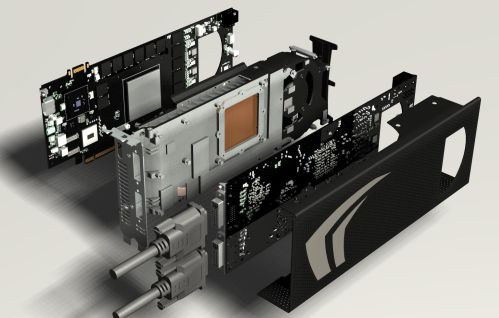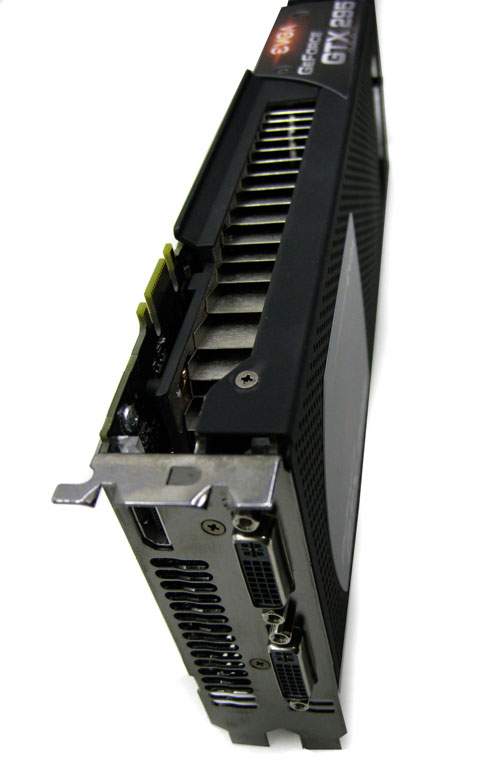

Review: Speed just got a new name
Today, our lab plays host to what will soon reveal to be the fastest graphics card around. It’s made by EVGA, a company well famous for overclocked models of Nvidia Geforce card and quite respected for its contributions to the OC business. The card is named Geforce GTX 295 HydroCopper, and uses water cooling. Clocks are nothing short of impressive – 720MHz GPU, 1548MHz shaders and 1080MHz (2160MHz effectively) memory. If you compare this to reference clocks you’ll realize this kind of overclock is something only EVGA will dare to do, as reference clocks are 576MHz GPU, 1240MHz shader and 999MHz (1998MHz effectively) memory. This means that the core has been overclocked by as much as 25% or 144MHz.

The photo above shows the GTX 295 HydroCopper’s from the back. The card also comes with EVGA’s backplate, a special plate that can be mounted on standard air-cooled GTX 295 cards, and EVGA currently sells it for $20. This plate helps with heat dissipation on the back of the card, and it’ll lower GPU temperatures by a couple of degrees Celsius in best case scenarios. Mounting the backplate however, isn’t mandatory of course but we must admit that the card looks much better with it on. The photo below shows the card without the backplate.

The waterblock is sandwiched between the two PCBs, on the spot where the reference card’s cooler was located. We expected the card to be heavier due to the large EVGA HydroCopper block, but it weighs about the same as the reference card. The block is made of aluminum and copper, and copper is used where the cooler and the GPUs meet.

Mounting is nothing out of the ordinary; all you need to do is connect the pipes to the fittings, which in our case were 3/8 inch. We finally fired this beast up and here are the results.

GPUZ confirms the 720MHz clocks and the 242GB/s bandwidth. Note that the reference card runs at 576MHz and has a
223GB/s bandwidth.
GT200 chip supports the 512-bit memory interface, but GTX 295 ended up using the 448-bit one. Both GT200 chips on the GTX 295 pack 240 shaders each, just like on the GTX285/GTX280 cards, and a simple multiplication will reveal that the card comes with 480 shaders. The texture units are all enabled and used, all 80 per chip.
In order to have a steady data flow between the two physically separate PCBs, Nvidia uses internal SLI that uses the interface located on the bottom of the printed boards, as you can see from the photo below. The Geforce GTX 295 can be chained up with another GTX 295 using the standard SLI connector on the top of the card, which will give you a mean Quad SLI with 4 GT200 chips.


Furthermore, each GTX 295’s chip features seven ROP and framebuffer partitions. Each ROP partition packs 4 ROP units, resulting in final 56 ROP units on the card. At the same time, each of the seven ROP partitions is linked to the main memory via a 64bit link, and this sheds some light on the 448-bit memory interface.
Each framebuffer partition is linked to the 128MB of memory, and since the card has 896MB of memory per GPU, the GTX 295 totals at 1792MB of GDDR3.
Before we take a look at the EVGA GTX 295 HydroCopper’s water block, let us remind you of how the reference cooling ran.
Since the GTX 295 features two hot GPUs, Nvidia made a “sandwich solution”. They designed a new cooler which Nvidia says brought 46% improvement compared to their other dual GPU/PCB card, Geforce 9800 GX2. The new heatsink and fan pack enough juice to dissipate more than 289w. The photo below shows the cooler sandwiched between the two PCBs, where both GPUs touch the cooler. The contact surface is made of copper, and you can see it on the photo below.

The fan blows air towards the I/O panel, pushing hot air out of the case, and the rest is released via the outlets on the top of the card. Adequate in-case airflow is of course very beneficial as it will help in keeping your components as cool as possible.

The card is of course PCIe 2.0 and it comes with two DVIs, both with 2560x1600 support, and one HDMI port. GTX 295 HydroCopper features the same connectors like the reference card.


The couple of following pictures show the HydroCopper block in more detail. You can see that, just like the reference card, the cooler uses copper for that quick heat transfer.


The graphics card on both sides of the block touch the copper part, whereas the rest of the cooler is made of aluminum. You can see that for yourself on the following photo.

The water circulates through the cooler, but not through both blocks at the same time, as the previous picture would make you think. Between the two external blocks you’ll find another block which separates the chambers and makes the flow constant and in one direction.

The memory comes from Hynix’s and is rated at 1GHz, but EVGA pushed it to 1080MHz.

The card requires one 6 and one 8-pin PCI-Express power connector, so we’d kindly recommend a PSU rated at 680W or higher.

The photo above shows the connectors on the aircooled EVGA GTX 295 card, whereas the photo below shows the same on the HydroCopper card.

Just like all the newere Geforce cards, the GTX 295 also comes with SPDIF audio connector located right next to the 6-pin power connector. EVGA ships a required cable with their cards, and you’ll be using it to bring the sound from your audio card/motherboard’s SPDIF out to the card, and then use a single cable to route both audio and video to your HDTV.
Before we move onto the results, we’ll talk about the temperatures and noise levels. The card is of course inaudible, and the temperatures are good especially after considering that the GPU runs at 720MHz. The reference card’s air cooling keeps the temperatures at about 83°C under a workload, whereas the GTX 295 HydroCopper’s GPU runs at 57°C in the same scenario. Idle temperatures are only 35°C.

This graphics card comes with three different operation modes, each with its own clocks. We’ve already seen the 3D mode, so the next photo shows the clocks when the card is in 2D mode. The core will run at either 399MHz or 300MHz, and the memory downclocks to only 100MHz.

The box resembles all the other EVGA cards’ packaging, but this time the packaging comes with the HydroCopper sign. Unfortunately, there’re no gift-games.

